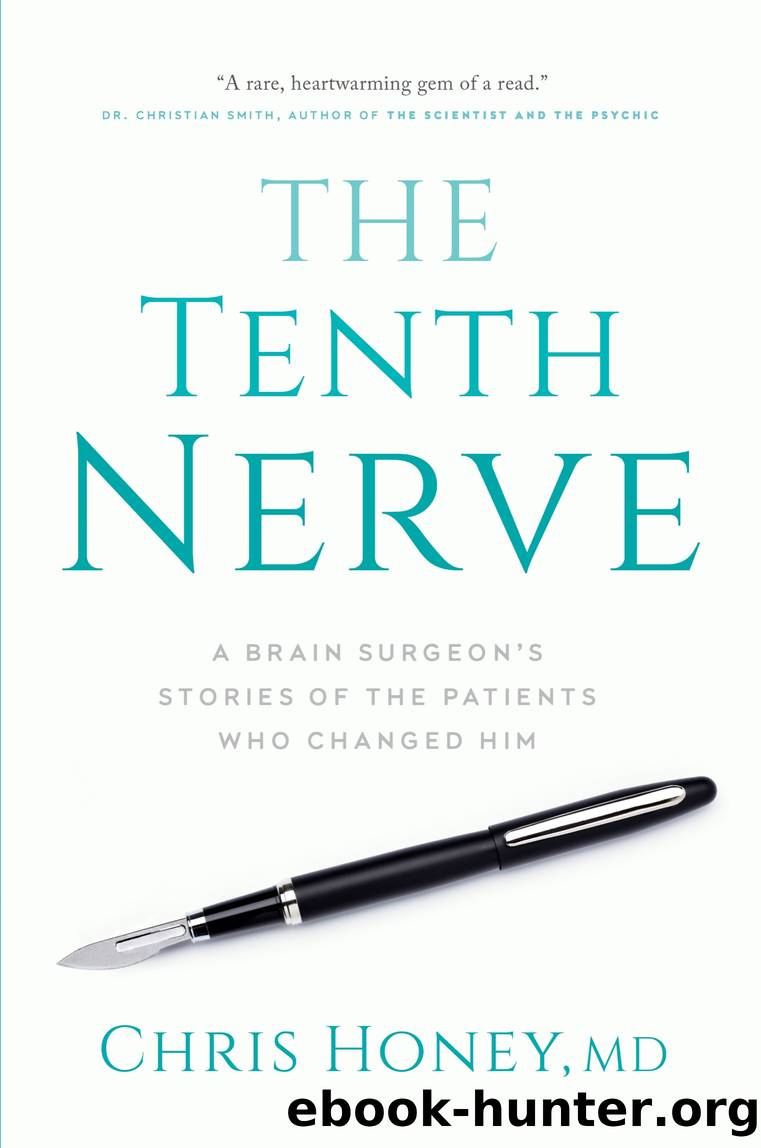The Tenth Nerve by Dr. Chris Honey

Author:Dr. Chris Honey [Honey, Chris]
Language: eng
Format: epub
Publisher: Random House of Canada
Published: 2022-02-08T00:00:00+00:00
8.
THE CURE
There was a brief moment of congratulations after Emilyâs operation, but little more than the acknowledgement of another successful brain surgery. Hours later, sitting at my office desk, looking out the window at Vancouverâs lights, I wondered, What the hell did I just find?
The unique juxtaposition of Emilyâs vagus nerve and her posterior inferior cerebellar artery explained her unusual symptoms. The surgery to correct it was, thankfully, completed without complication. It remained to be seen whether her problem was solved, but I felt confident about the outcome.
And now the ramifications of what I had seen began to sink in. There must be hundreds of people with Emilyâs problem. Maybe thousands? This was the recognition of a new disease.
Then the doubts flooded in. How would I convince my colleagues this disease even existed? Why had it not been described before? How would I find these patients? Maybe this disease had been described before under another name. And if it hadnât, what name was I going to give it?
The naming of a new medical condition has changed styles over the years. Historically the disease might be given the name of the physician who discovered it or the place where it was discovered. James Parkinson (1755â1824) is the source of the name for Parkinsonâs disease, which he first wrote about in 1817. More recently, researchers use universal terms to describe new conditions. I would get to name this condition because I had discovered it.
The World Health Organization has put out guidelines for naming new human diseases (that I had not yet read at the time). They recommend that new human diseases not include place names (e.g., Spanish flu, German measles, or Wuhan virus) because it could engender racism. Some are still named for placesâEbola is a river in the Democratic Republic of Congo, and Lyme is a town in Connecticut. The WHO also does not like peopleâs names, specific animals or scary adjectives associated with a disease.
Prion diseases, the worldâs most lethal diseases, with no cure and a 100 percent death rate, are a group that include fatal familial insomnia, Creutzfeldt-Jakob disease, kuru and mad cow disease. They break all the rules of naming. To be given the diagnosis of fatal familial insomnia must be truly frightening. Only kuru might be acceptable to the WHO, although the questionable circumstances around its discovery were certainly not. Kuru is the Fore word âto shake,â one of the symptoms that preceded death in this isolated tribe in Papua New Guinea. The researcher who discovered the disease deduced that it was transmitted by the cannibalistic ritual of eating the brains of your dead enemies or relatives. He was lauded as a Nobel laureate but later reviled as an unrepentant pedophile. The mad cow disease outbreak in England had a similar mode of transmission, through animal feed contaminated with the brains of the beastsâ fallen brethren.
Originally, I had looked for patients with unilateral contractions of their throat (choking). If a vessel pressing on the facial nerve could
Download
This site does not store any files on its server. We only index and link to content provided by other sites. Please contact the content providers to delete copyright contents if any and email us, we'll remove relevant links or contents immediately.
| Anesthesiology | Colon & Rectal |
| General Surgery | Laparoscopic & Robotic |
| Neurosurgery | Ophthalmology |
| Oral & Maxillofacial | Orthopedics |
| Otolaryngology | Plastic |
| Thoracic & Vascular | Transplants |
| Trauma |
Periodization Training for Sports by Tudor Bompa(8173)
Why We Sleep: Unlocking the Power of Sleep and Dreams by Matthew Walker(6619)
Paper Towns by Green John(5092)
The Immortal Life of Henrietta Lacks by Rebecca Skloot(4528)
The Sports Rules Book by Human Kinetics(4299)
Dynamic Alignment Through Imagery by Eric Franklin(4119)
ACSM's Complete Guide to Fitness & Health by ACSM(3989)
Kaplan MCAT Organic Chemistry Review: Created for MCAT 2015 (Kaplan Test Prep) by Kaplan(3940)
Introduction to Kinesiology by Shirl J. Hoffman(3726)
Livewired by David Eagleman(3686)
The Death of the Heart by Elizabeth Bowen(3554)
The River of Consciousness by Oliver Sacks(3543)
Alchemy and Alchemists by C. J. S. Thompson(3452)
Bad Pharma by Ben Goldacre(3358)
Descartes' Error by Antonio Damasio(3232)
The Emperor of All Maladies: A Biography of Cancer by Siddhartha Mukherjee(3069)
The Gene: An Intimate History by Siddhartha Mukherjee(3050)
The Fate of Rome: Climate, Disease, and the End of an Empire (The Princeton History of the Ancient World) by Kyle Harper(3007)
Kaplan MCAT Behavioral Sciences Review: Created for MCAT 2015 (Kaplan Test Prep) by Kaplan(2941)
